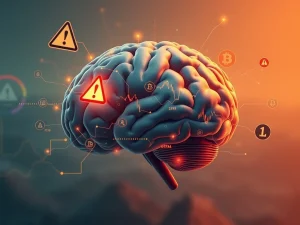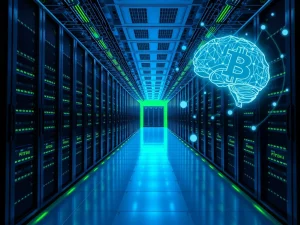AI Agents Set to Revolutionize Stablecoin Usage: Novogratz Predicts Explosive Growth

The digital financial world stands on the cusp of a significant transformation. Mike Novogratz, CEO of Galaxy Digital, recently shared a bold prediction. He believes **AI agents** will soon become the primary users of **stablecoins**. This shift could trigger an explosion in stablecoin transactions. This forecast highlights a future where autonomous AI systems manage our daily finances. It also suggests a new era for digital currency adoption.
The Emergence of AI Agents and Stablecoin Adoption
Mike Novogratz envisions a future where artificial intelligence plays a central role in everyday transactions. During a recent Bloomberg interview, he stated that “in the not-so-distant future, the biggest user of stablecoins is going to be AI.” This vision suggests a profound change. He described a scenario where an AI agent could handle grocery shopping. This agent would know your dietary preferences and independently make necessary purchases. It would select items from various stores without human intervention.
AI agents are autonomous software programs. They perceive their environment, make decisions, and take actions. They achieve goals without constant human input. Their high degree of independence distinguishes them from current AI systems. Novogratz emphasized that such an agent would not use traditional banking methods. It would not “send a wire instruction or a Venmo.” Instead, it would rely entirely on **stablecoins** for transactions. He acknowledged uncertainty about the exact timeline, suggesting it could be one or five years away. Regardless, he anticipates “an explosion of stablecoin transactions.”
Why Stablecoins Are Crucial for AI-Driven Crypto Payments
The choice of stablecoins for AI agents is not accidental. Stablecoins offer several key advantages over traditional payment systems. First, they provide price stability. This stability is essential for automated transactions. AI agents need predictable values to manage budgets and execute purchases efficiently. Second, stablecoins operate on blockchain technology. This allows for fast, low-cost, and borderless transactions. Traditional banking methods often involve delays and higher fees. Third, stablecoins enable programmable money. This feature allows AI agents to execute complex financial logic automatically. This includes conditional payments or automated budget allocations. Therefore, stablecoins are ideal for the independent operation of **AI agents**.
Expanding Reach: Stablecoins and Crypto Payments See Growth
Novogratz’s predictions align with current trends. Reports indicate significant growth in **stablecoin** adoption for payments. Early June reports revealed that major tech companies are exploring stablecoins. Apple, X, Airbnb, and Google are among them. They seek to lower fees and improve cross-border payments. This interest signals a broader acceptance of digital currencies.
Recent partnerships and initiatives further underscore this trend:
- Global grocery giant Spar now supports stablecoin and cryptocurrency payments in Switzerland.
- E-commerce leader Shopify rolled out early access to USDC stablecoin payments. This was in collaboration with Coinbase.
- Payment company Visa expanded its stablecoin offerings. It added support for USDG, PYUSD, and EURC.
A mid-May survey of 295 executives confirmed this institutional interest. It covered traditional banks, financial institutions, fintechs, and payment gateways. A striking 90% of these players are either using or exploring stablecoins. This data suggests a strong foundation for future growth in **crypto payments**.
Bridging AI Agents with Web3 Integration
The concept of **AI agents** participating in Web3 is gaining traction. Coinbase development team members stated that AI agents “are about to become Ethereum’s biggest power users.” These systems possess distinct capabilities compared to humans. They interact with blockchain networks differently. This necessitates specialized infrastructure and middleware. Adrian Brink, co-founder of Web3 AI agent infrastructure firm Anoma, highlights this need. He claims such systems require intent-based blockchain infrastructure. This infrastructure uses user-defined goals. It prevents unexpected transaction outcomes. This ensures predictable and secure operations for AI agents.
Investment in this sector is also rising. Decentralized AI agent infrastructure startup Kite AI recently raised $18 million. This Series A funding round was led by PayPal Ventures. It brings their total cumulative funding to $33 million. This investment underscores confidence in the future of AI and Web3 convergence.
Real-World Applications: Clanker and the Future of Web3 Integration
One compelling example of an AI agent integrated into Web3 infrastructure is Clanker. Clanker is a decentralized application (DApp). It uses an artificial intelligence agent to create memecoins based on user prompts. “Clanker is an AI that launches crypto tokens for you,” its website states. “Give it a name and symbol, and it handles deployment, market creation, and fee sharing automatically.” This DApp demonstrates the practical application of AI in crypto. It simplifies complex blockchain tasks. Early August reports indicated Clanker had generated over $34.4 million in fees for its users. This highlights the potential for AI agents to create value within the Web3 ecosystem. Such innovations are crucial for driving wider **Web3 integration**.
The Transformative Impact of AI Agents on Stablecoin Transactions
The convergence of **AI agents** and **stablecoins** promises a transformative impact on financial markets. Mike Novogratz’s prediction of an “explosion of stablecoin transactions” stems from this synergy. AI agents will not only automate existing processes. They will also unlock entirely new use cases. Imagine autonomous businesses managed by AI. These entities could use stablecoins for all their financial operations. This includes payroll, supply chain payments, and investment. This level of automation would significantly increase transaction volume. It would also reduce friction in global commerce. The future could see AI-driven financial ecosystems operating seamlessly on blockchain rails. This would leverage the efficiency and stability of stablecoins.
Conclusion: A New Era for Stablecoins and AI Agents
Mike Novogratz’s vision paints a compelling picture. **AI agents** are poised to become the dominant users of **stablecoins**. This will reshape the landscape of **crypto payments** and **Web3 integration**. The growing adoption of stablecoins by major tech companies and institutions reinforces this outlook. As AI technology advances, its financial capabilities will expand. This will lead to an unprecedented volume of stablecoin transactions. This convergence represents a significant leap forward. It promises a more automated, efficient, and interconnected global financial system.








